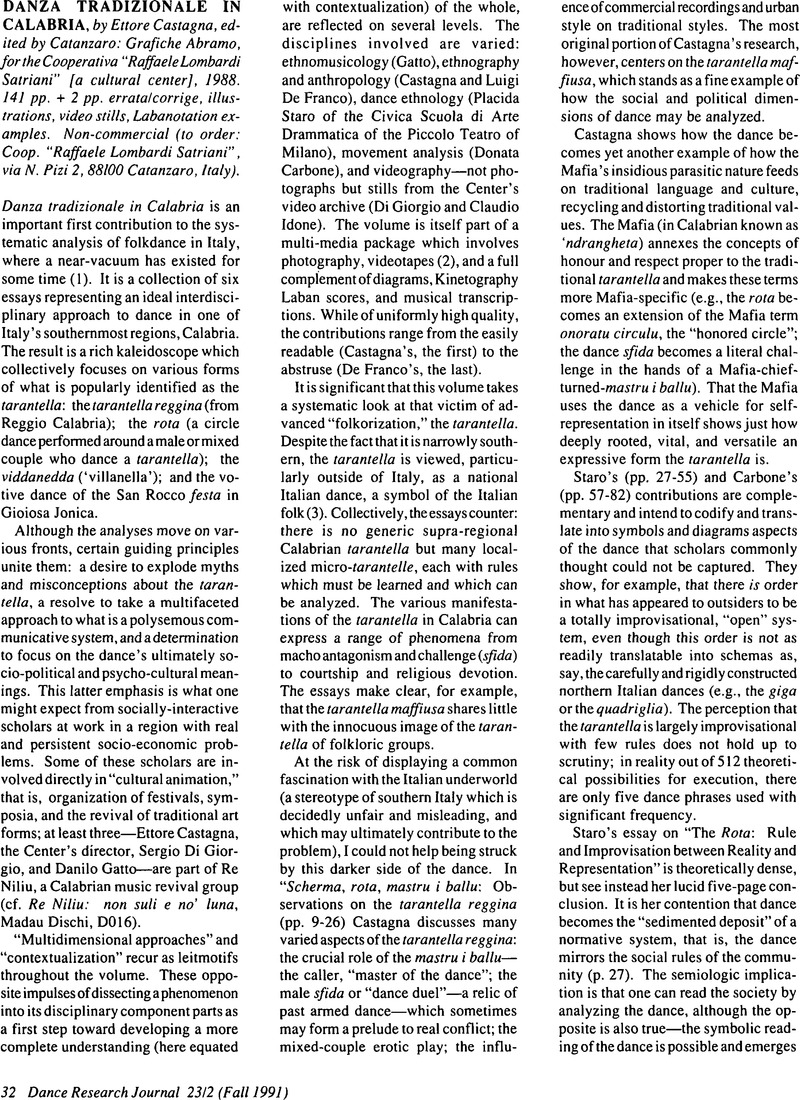No CrossRef data available.
Article contents
Danza Tradizionale in Calabria, by Ettore Castagna, edited by Catanzaro : Grafiche Abramo, for the Cooperativa “Raffaele Lombardi Satriani” [a cultural center], 1988. 141 pp. + 2 pp. errata/corrige, illustrations, video stills, Labanotation examples. Non-commercial (to order: Coop. “Raffaele Lombardi Satriani”, via N. Pizi 2, 88100 Catanzaro, Italy).
Published online by Cambridge University Press: 22 July 2014
Abstract

- Type
- Reviews
- Information
- Copyright
- Copyright © Congress on Research in Dance 1991
References
Notes
1. The methodologie innovations of this work go far beyond past, largely historic-philologic works in the field (e.g. A.G. Bragaglia, Danze popolari italiane, 1950; G. D'Aronco, Storia della danza popolare e d'arte, 1962).
2. Four videos produced by the Center focus on dance: La viddanedda di Cataforio, Festa della Madonna di Polsi, Festa di San Rocco, and S. Eufemia d'Aspromonte. Of the multi-media package, only the videotapes are not treated in this review.
3. On the tarantella as a trance dance cf. De Simone, Roberto, Canti e tradizioni popolari in Campania, Rome: Lato Side (No. 19), 1979.Google Scholar On the relation between dance and eros in the Italian tradition, cf. Del Giudice, Luisa, “Ubi saltatio ibi diabolus: Dance and Eros in the Italian Ballad and Dance Song,” in Petzoldt, Leander, Top, Stefaan (eds.), Dona Folcloristica: Festgabe für Lutz Röhrich zu seiner Emeritierung (Frankfurt a.M: Peter Lang, 1990) 57–67.Google Scholar
4. By a circular logic one prays to San Rocco for the capacity to dance (if one can dance long and hard, it is a sign of one's good health) and if one is in good health one dances in gratitude to San Rocco.
5. On a minor note, the volume is sprinkled with myriad typographical errors, some serious, some amusing (e.g., “trade d' union” for “trait d' union” [p. 13]—not corrected in the appended 2 pp. errata corrige). Finally, the scant dialect terms, reserved only for the dance leader, mastru i ballu (=It. maestro di ballo) and for a few of the dances, e.g., viddanedda (=It. villanella), rota (=It. ruota), seem as arbitrary by their inclusion as does the exclusion of others (e.g., why not tarantedda?)




